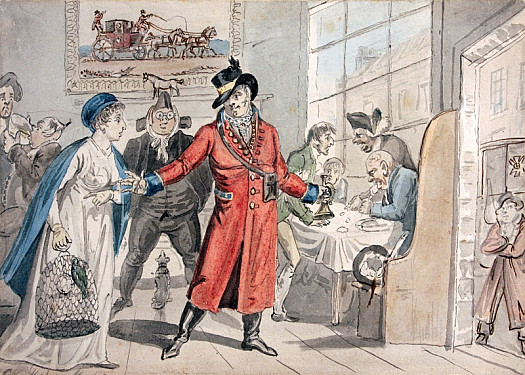The second son of the caricaturist Isaac Cruikshank, George Cruikshank was born in Bloomsbury, London on 27 September 1792, probably at the family home at 27 Duke Street (now Coptic Street). By 1808, the family had moved to 117 Dorset Street (now Dorset Rise), Salisbury Square, close to St Bride’s, Fleet Street. Like his elder brother, Robert, he received a basic education at a school in Edgware.
Working with his father from an early age, Cruikshank began to publish in 1806. Then, following his father’s death from alcohol abuse in 1811, he supported the family through his work as a graphic artist, gradually becoming the leading political caricaturist of his day. He completed James Gillray’s last work for the publisher Hannah Humphrey, and collaborated with the radical publisher William Hone, as well as producing many caricatures of his own.
Turning to book illustration in 1820, he worked with his brother, Robert, and the writer, Pierce Egan, on Life in London (1820-21), which surveyed the capital’s highs and lows through the lives of two friends, Tom and Jerry.
From 1823, the Cruikshank family lived at 11 Myddleton Terrace, overlooking Claremont Square, Pentonville. In the following year, George rented 25 Myddleton Terrace, and continued to live there following his marriage in 1827. (His first wife, Mary Ann, suffered from ill health and would die childless in 1849.)
Throughout the 1820s, as he established himself as an illustrator, Cruikshank became increasingly conservative, moulding his grotesque style to the sense of humour of a respectable middle-class public. William Makepeace Thackeray wrote that it was Cruikshank who ‘brought English pictorial humour and children acquainted’, and this was achieved in great part by his edition of the Grimm brothers’ German Popular Stories (1823). Almanacs were issued from 1835 to 1853 under the artist’s name and these were succeeded by George Cruikshank’s Magazine (1853-54). But he did not exclude the seamier side of life from his visual world, and showed great sensitivity towards misery, vice and crime in Charles Dickens’ Oliver Twist (1838) and the romances of Harrison Ainsworth.
Cruikshank’s conversion to the teetotal cause in the late 1840s gave a focus to his moral outrage and invigorated a flagging reputation. He worked intensively in the last 30 years of his life, primarily for the Temperance League, producing such striking images as the two series of prints, The Bottle (1847) and The Drunkard’s Children (1848), and the vast masterpiece, The Worship of Bacchus (1863, Tate). The critic, John Ruskin did not appreciate this turn in Cruikshank’s career and tried to assist him, artistically and financially, by encouraging him to illustrate a new edition of Grimm. However, his work on this project seemed coarse to Ruskin and it was never completed.
In 1850, Cruikshank had married for a second time, to Eliza Widdowson, a niece of the publisher Charles Baldwyn, who had commissioned the first volumes of German Popular Stories. They moved with family members and servants into 48 Mornington Place, Mornington Crescent (which would be renamed 263 Hampstead Road in 1864). However, the apparent respectability of the household proved deceptive. In 1854, the housemaid, Adelaide Attree, admitted she was pregnant, and Eliza dismissed her without realising that George was the father. George set up Adelaide in a nearby flat that he used as a studio, and is believed to have fathered a further ten children with her during the next 20 years. Maintaining two households inevitably put a strain on his finances, and at a time that his work was markedly less successful. On his death, Eliza discovered that he had left his entire estate to Adelaide while actually being insolvent.
Cruikshank died at home of an acute respiratory infection on 1 February 1878. First buried at Kensal Green, his body was later removed to St Paul’s Cathedral as an acknowledgement of his work for the temperance movement.
His work is represented in numerous public collections, including the British Museum, The Courtauld Gallery and the V&A; and the New York Public Library, Princeton University Library and the University of Delaware Library.
Further reading:
John Buchanan-Brown, The Book Illustrations of George Cruikshank, Newton Abbot: David and Charles, 1980 A M Cohn, George Cruikshank: A Catalogue Raisonné, London: The Bookman’s Journal, 1924; William Feaver, George Cruikshank, London: Arts Council of Great Britain, 1974; Ruari McLean, ‘Cruikshank (3) George Cruikshank (b London, 27 Sept 1792; d London, 1 Feb 1878)’, Jane Turner (ed), The Dictionary of Art, London: Macmillan, 1996, vol 8, pages 217-218; Robert L Patten, ‘Cruikshank, George (1792-1878)’, H C G Matthew and Brian Harrison (eds), Oxford Dictionary of National Biography, Oxford University Press, 2004, vol 14, pages 520-528; Robert L Patten, George Cruikshank’s Life, Art and Times, Cambridge: Lutterworth, 1992 & 1996 (2 vols); John Wardroper, The Caricatures of George Cruikshank, London: Gordon Fraser, 1977

